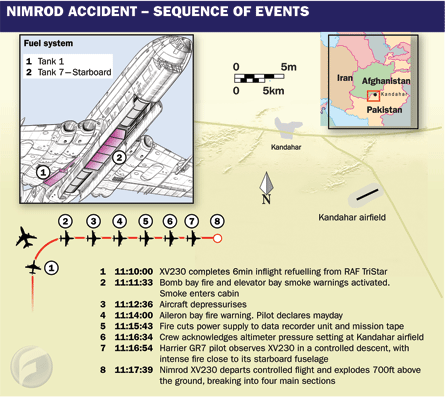Age of airframe not a factor in crash that killed 15 on 2006 Afghanistan mission
The UK Ministry of Defence failed to properly recognise the risks posed by fuel system leaks aboard the Royal Air Force's British Aerospace Nimrod MR2 reconnaissance aircraft for around two decades prior to an accident that killed 14 people in Afghanistan last year, a board of inquiry report concludes.
Nimrod XV230 suffered a catastrophic fire immediately after receiving 9,980kg (22,000lb) of fuel from an RAF Lockheed Tristar tanker on 2 September 2006, with fuel vented from the aircraft's No 1 fuel tank igniting on hot air pipes in the No 7 tank dry bay towards the rear of its starboard wing the most probable cause. The latter area houses a cross-feed pipe carrying hot engine bleed air at temperatures in excess of 400°C to a supplementary cooling pack (SCP), and contains no fire detection or suppression systems.
After refuelling for 6min, XV230 climbed to 22,000ft and turned east towards Kandahar. The SCP had unexpectedly shut down during refuelling, which the report says "could have been occasioned by the early stages of a fire." Around 90sec after separating from the tanker, the crew received near-simultaneous alerts from the Nimrod's bomb bay firewire and elevator smoke warnings. The aircraft's cabin depressurised within a further 1min, shortly before its pilot declared a mayday.
Witnessed by a UK Joint Force Harrier pilot and Canadian ground forces, the aircraft disintegrated 700ft (210m) above the ground either before or as its No 7 fuel tank suffered a boiling liquid expanding vapour explosion, with its wreckage landing in four main sections.
The report says the crew were initially unaware of the severity of the fire, noting: "Until approximately 90sec before the crash, the crew believed that they were going to be able to reach Kandahar airfield." But control was lost 14nm (26km) short, after fire cut hydraulic power to the aircraft's control surfaces. "Nothing that could have been done would have altered the outcome," says the BOI.
The RAF confirms that "the threat of fuel entering the fuselage compartments [following No 1 tank blow-off] was raised" during flight testing of BAe's cancelled Nimrod AEW3 airborne early warning aircraft in the mid-1980s, but says: "There is no evidence that it was ever investigated further.```"
The service describes this discovery as "particularly disturbing", with subsequent analysis having found that the XV230's No 1 tank blow-off valve had been activated on two previous occasions during the crew's previous three sorties in theatre. However, the BOI says fuel streaks on the starboard fuselage and from the No 7 tank dry bay's vents were "interpreted as a normal function of the aircraft system".
Use of the SCP has been banned, and with this potential source of ignition no longer active, chief of the air staff Air Chief Marshal Sir Glenn Torpy says he is "content that the aircraft is fit to fly." However, inflight refuelling of the Nimrod is currently prohibited after an aircraft suffered a major fuel leak over Afghanistan on 5 November, and "considerable amounts of fuel" also poured into the No 7 tank dry bay of another aircraft during ground refuelling last February.
Citing maintenance policies for the Nimrod's fuel and hot air systems as having contributed to the loss of XV230, the BOI says: "The age of the airframe was not a factor." The Nimrod Safety Case - described in the report as containing an "overly optimistic hazard/risk categorisation", will be the subject of a fresh review. The MR2 fleet will be replaced by 12 BAE Systems Nimrod MRA4s from 2010, with the last to be retired in 2012.
 |
|---|
Source: Flight International
















